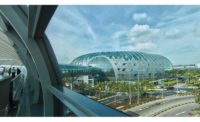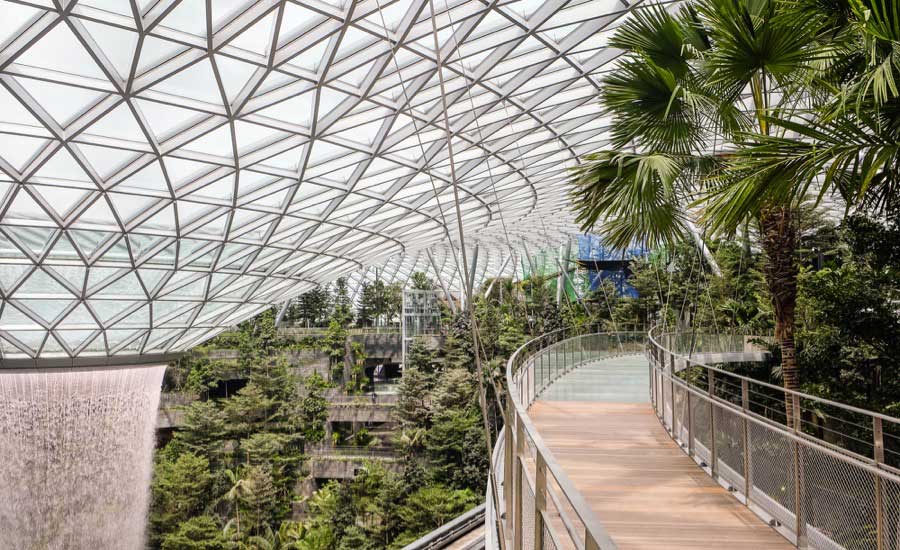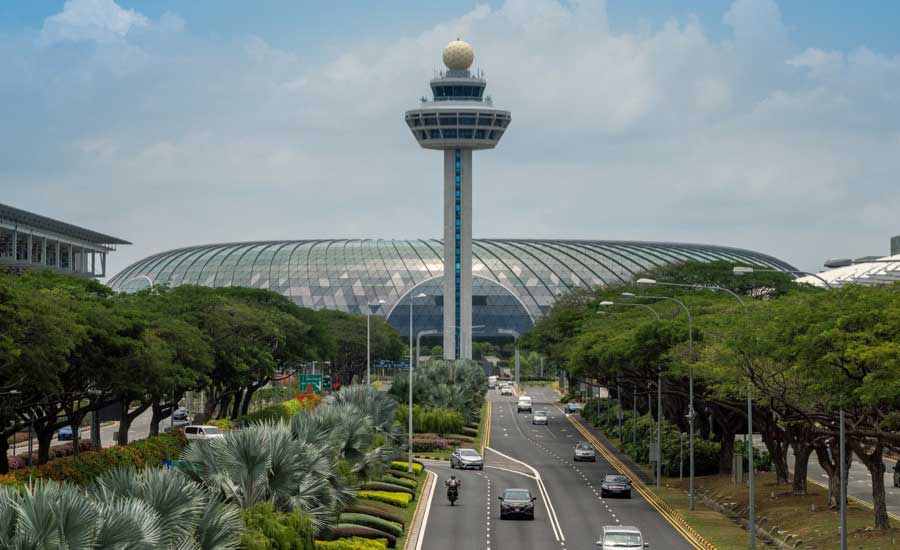Moshe Safdie’s Jewel Changi Airport in Singapore Opens to the Public

The airport’s skytrain travels through the Jewel, providing a glimpse of the rain vortex to passengers in transit between terminals.
Photo © Jewel Changi Airport Devt

A bridge suspended 25 feet above ground level connects some of the attractions of the building’s top floor, known as the canopy park.
Photo © Petra Loho

Smaller water features are included in the terraced landscape of the forest valley.
Photo © Petra Loho

Architect Moshe Safdie gives journalists a tour of the Jewel in early April.
Photo © Petra Loho

The rain vortex at the center of the Jewel is the world’s tallest indoor waterfall.
Photo © Jewel Changi Airport Devt

Singapore’s new Jewel Changi Airport is enclosed by a toroidal glass-and-steel roof that spans 650 feet at its widest point.
Photo © Darren Soh

The canopy park has features that include a hedge maze and a bouncing net (shown).
Photo © Jewel Changi Airport Devt







The Jewel, a $1.26 billion development that combines retail, restaurants, entertainment venues, and lush gardens under a vast toroidal glass roof, opened today at Singapore’s Changi Airport. The 1.5-million-square-foot structure aims to transform “the airports principal function as a transit hub into an interactive civic and urban center,” says Moshe Safdie, principal of Safdie Architects, the project’s lead design firm.
Its developers, Changi Airport Group (CAG) and real-estate company CapitaLand, hope the Jewel will entice travelers to choose Singapore as a stop-over destination and also serve as a draw for local residents. The mixed-use complex, which extends five stories above ground and five stories below, connects three of the airport’s current four terminals. In addition to almost 600,000 square feet of retail space, it includes a terraced forest, a hotel, a movie theater, and airport services, such as early check-in counters and passenger lounges.
At the center of the toroid is a 130-foot-high waterfall that is reportedly the world’s tallest such indoor water feature. Dubbed the “rain vortex,” water is supplied through a system of 24 concealed pipes to the rim of the oculus and then pours through the opening at a rate of 10,000 gallons per minute during the day. (In the evening, the velocity is reduced to about 1,500 to 2,000 gallons to a minute to facilitate a light show.) The water is collected in a 132,000-gallon tank in one of the basement levels for reuse in the building. Having such a large quantity of water flow through the opening in consistent manner was the rain vortex’s greatest challenge, according to Ashith Alva, Jewel Changi’s head of projects. Its design, developed by the fountain specialists WET, required a two-year process of prototype testing and on-site fine-tuning, says Alva.

Photo © Jewel Changi Airport Devt
Wrapping the waterfall is the “forest valley” on four levels and a “canopy park,” with attractions that include a hedge maze and a topiary walk, on the top level. Designed in collaboration with PWP Landscape Architecture, these gardens contain about 2,000 trees and 100,000 shrubs procured from around the world and selected for their aesthetics and their ability to thrive with the Jewel’s light levels and its temperature and humidity conditions. Although visitors will not mistake the forest valley for an actual wooded environment, it offers a welcome alternative to the usual frenetic airport experience. Walking along the stacked trails, you hear soothing sounds like birdsongs transmitted via speakers. You can also feel cool air rising from floor-level vents, since the building relies on displacement ventilation—an air distribution strategy that involves conditioning only the occupied zones of the Jewel’s immense volume. “Everywhere else remains at natural temperature,” explains Jean Hung, Jewel Changi’s CEO.
The project is part of a larger airport expansion plan that includes renovation of Terminal 1. Slated for completion later in 2019, the revamped terminal is expected to increase Changi’s carrying capacity from about 65 million to 85 million passengers per year. Construction on a fifth terminal designed by Heatherwick Studio, KPF, and Architects 61 is scheduled to start in 2020.










